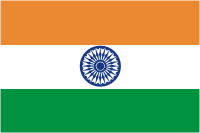
So they have a lot of forts in India - it's pretty clear that any established society required the protection of a well located military position in mideval India, and Hyderabad is no exception. We have visited quite a few already in Delhi and Jaipur, so I wan't expecting anything too different from what I had already seen, but Hyderabad's Golconda Fort rises above the city on an interesting hill. The original structure was built in 1143 during the reign of Ibrihim Qutb Shah. The entry gate contains an interesting accoustical feature - the "clapping portico", which is an area in which a guard who claps his hands can be heard a few hundred feet away. There are various structures along the climb to explore - foundary, magazine, Royal Quarters, barracks, and finally at the top there is a mosque and a fantastic temple that is protrudes from the rocks. Hindu temples often have an exceptional flare for finding some sort of balance with the natural environment - some sort of intrinsic architectural zen or feng shui. The structure is juxtaposed against the landscape in a purposeful way that also creates visual balance and harmony. I find this to be a really unique feature.

This temple is perched high on a mountaintop and the color and prayer flags gave it an almost Nepalese feel.
The Fort is close to the old city of Hyderabad and we found it to be predominately Muslim. The married Muslim women will wear the Burka - a complete covering of the body from head to toe in black - sometimes even the hands. Unmarried Muslim girls dress no differently than all other Indian girls - mostly long, colorful dresses, salwar kameez, or saris. Men will sometimes wear a small cylindrical cap, or kufie, on the tops of their heads. When we arrived near the gate we were approached by a large group of women in burkas who were curious about Evan and Eli. They wanted to touch their cheeks and speak with them - it was a nice exchange and they soon removed their face coverings and agreed to a photo with Jessie and Eli.

One of the interesting things I have noted about the general culture in India is the separation of genders in public spaces. Boys and girls sit apart from each other in classrooms, and I have noted that Indian women will keep a large physical distance from me during any type of interaction - even with colleagues from the school. The distance is usually at least 3 steps away, and the conversations are usually short and to-the-point. On the contrary, relationships with men are warm and close, with men openly choosing to shake hands, pat backs, and the like. I don't think I've shaken hands with an Indian woman since I arrived here - only folded hands and a "Namaste" or "Namaskar" greeting. There is no "bubble" space with men.
 So they have a lot of forts in India - it's pretty clear that any established society required the protection of a well located military position in mideval India, and Hyderabad is no exception. We have visited quite a few already in Delhi and Jaipur, so I wan't expecting anything too different from what I had already seen, but Hyderabad's Golconda Fort rises above the city on an interesting hill. The original structure was built in 1143 during the reign of Ibrihim Qutb Shah. The entry gate contains an interesting accoustical feature - the "clapping portico", which is an area in which a guard who claps his hands can be heard a few hundred feet away. There are various structures along the climb to explore - foundary, magazine, Royal Quarters, barracks, and finally at the top there is a mosque and a fantastic temple that is protrudes from the rocks. Hindu temples often have an exceptional flare for finding some sort of balance with the natural environment - some sort of intrinsic architectural zen or feng shui. The structure is juxtaposed against the landscape in a purposeful way that also creates visual balance and harmony. I find this to be a really unique feature.
So they have a lot of forts in India - it's pretty clear that any established society required the protection of a well located military position in mideval India, and Hyderabad is no exception. We have visited quite a few already in Delhi and Jaipur, so I wan't expecting anything too different from what I had already seen, but Hyderabad's Golconda Fort rises above the city on an interesting hill. The original structure was built in 1143 during the reign of Ibrihim Qutb Shah. The entry gate contains an interesting accoustical feature - the "clapping portico", which is an area in which a guard who claps his hands can be heard a few hundred feet away. There are various structures along the climb to explore - foundary, magazine, Royal Quarters, barracks, and finally at the top there is a mosque and a fantastic temple that is protrudes from the rocks. Hindu temples often have an exceptional flare for finding some sort of balance with the natural environment - some sort of intrinsic architectural zen or feng shui. The structure is juxtaposed against the landscape in a purposeful way that also creates visual balance and harmony. I find this to be a really unique feature.




No comments:
Post a Comment